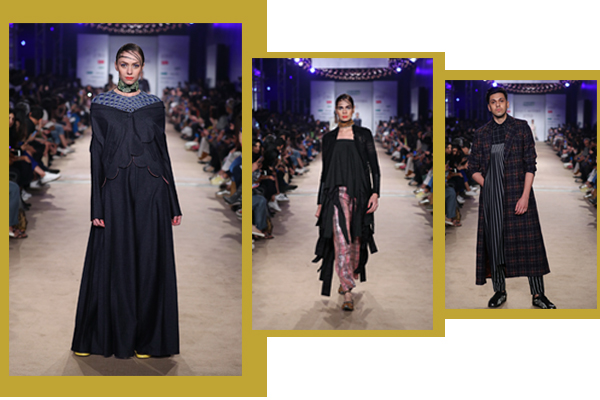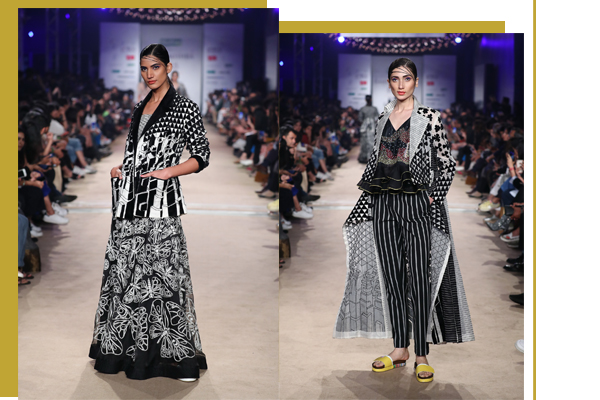Day two of LMIFWAW19 was witness to some of the most experimental looks. Whether it was the colour pink breaking the myth of its dainty stereotype, or Huemn and Nitin Bal Chauhan’s monochrome looks, breaking the mould seemed to be the trend this season.
Gauri and Kunal –
Emerging from beneath a bedazzled hairband were two incredibly teased ponytails, a fresh departure from the sleek hair witnessed on day one. Reminiscent of the 80’s perm, the hairdo was a perfect addition to the duos vibrant co
llection. Natural dewy skin flushed cheeks and long lashes added to the refreshing look.

PC : Diya Mathur
Prerna Adsul
Inspiration the Curve by Prerna Adsul was a revelation in more ways than one. In addition to the shows inclusivity and breath taking garments was an incredible showcase of hair and make up, featuring untamed and slicked back tresses. Balancing this was dewy skin, subtle contouring and on the lips — a burnt umber that added an element of intensity.

PC : Diya Mathur
Sanjukta Dutta
Flushing a precisely contoured face was the colour pink — seen on the high points of the cheek and creases of the eyelid, all sobered down with a nude colour on the lips and finished with a classic cat eye. Completing this drastic yet effective make-up was a simple hairdo, neatly tied at the back. Showstopper Karisma Kapoor graced the ramp in a look reminiscent of timeless elegance – a sari and a bun.

PC : Diya Mathur
Julie Shah
Julie Shah’s experimental collection was complimented with pink contouring, a variation of the classic trick to add dimension to the face. The creases of the eyes saw a pigmented pink, which extended till the eyebrows. A coral colour was used on the lips and cheeks to brighten up the look. Finishing touches included a teased ponytail, with no presence of a parting.
Nikita Mhaisalkar, Nirmooha by Prreeti Jaiin Nainutia, Pooja Shroff and Siddhartha Bansal
Pink seems to be the recurring leitmotif in make-up this fashion week, as it’s different treatments in a variation of hues breaks the myth of it being nothing but a ‘pretty’ colour.
Four designers with distinct collections are united by pink, as the showcase sees the colour powdered onto the model’s cheekbones, creating an effect of unique sophistication. Locks of hair are separated only to meet again in a high bun that is teased to perfection.
 PC : Diya Mathur
PC : Diya Mathur
Prashant Verma –
In complete harmony of Verma’s performance of a show was the make-up that much like stage make-up featured an unquestionable base and precise eyeliner on a contoured face, with a touch of lip colour to finish off the look. While the dancers played their part, actors wearing Verma’s gowns walked the ramp in buns – some side-parted and sleek while the others were half up, high and mighty.

PC : Diya Mathur
Huemn —
As designers, Pranav Misra and Shyma Shetty called for change, models stormed the runway in make up that was a complete departure from the normal — eyes smeared with black kohl and metallic white paint, and the face contoured in stripes of black.
Eyebrows were thickened beyond the usual, and filled in with dark colours. The cupid’s bow saw a stark ivory shade, which was also present sporadically along the hairline and the lower lash line. The look was finished off with a wet hair do, slicked back and left to its natural fall with a soft shine from the product used.

PC : Diya Mathur
Nitin Bal Chauhan –
Pushing every boundary was Nitin Bal Chauhan, who took his inspiration from Edie Campbell and Alan Moore’s graphic novel, “FROM HELL”, and translated it to hair and make up with the use of sharp angular lines and manipulation of form. Slicked back tightly was the hair that went around circular metallic frames to create hollow buns and ponytails. Adding to Chauhan’s monochromatic colour palette were red strips of hair, parted from the side and clipped on gently.
Crafted carefully was the make up, with precise lines to add dimension, expression and in some cases – tear drops. The use of black and white was to mimic the design language of a graphic novel, and helped enhance the illusion.

PC : Diya Mathur
Samant Chauhan –
Adding to Chauhans vision in white was an ethereal make up treatment, which included soft contouring and shimmering highlighter. Adding colour to this predominantly bronze look, was a warm hue on the high points of the cheek and lips, finished off with a generous use of mascara. Hair was parted from the centre to create two pony tails, that were left to look natural and placed behind the back and in some cases, over one shoulder.

PC : Diya Mathur
Suneet Varma –
Adding to the glitz and glamour of Suneet Varma’s sparkling collection was a bronze base, perfectly contoured skin and highlighter on the high points of the cheek, cupids bow and eyebrow bone. An ivory shimmer brightened up the eyes, and was completed with a soft smoky eye and a soft pink shade on the lips. There were no compromises on the hair, which was braided, teased and met at the back of the head in an elaborate and graceful bun.

PC : Diya Mathur







































